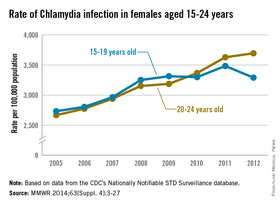The rate of chlamydia infection for females aged 15-19 years dropped significantly in 2012, while the rate of infection for 20- to 24-year-old females continued to rise, the Centers for Disease Control and Prevention reported.
Chlamydia infection rates increased steadily from 2005 to 2009 for females aged 15-19 years, to a high of just over 3,300 per 100,000 population, but has remained near that rate, with a large rise in infection rate in 2011 balanced by the drop in 2012, according to the CDC.
There was no similar leveling off of infection rates for women aged 20-24 years, with chlamydia infection rates increasing from about 2,700 per 100,000 in 2005 to over 3,700 in 2012, an average annual increase of 4.9% a year.
“The observed increase in diagnosis reflects, at least in part, an increased effort to screen more women for chlamydia infection and bring more infected women in for treatment,” the CDC noted (MMWR 2014;63[Suppl. 4]:3-27).
The report used data from the CDC’s Nationally Notifiable STD Surveillance database.


